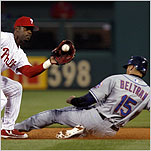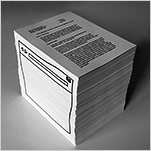Ah, yes, $500 billion in bailout money here, a trillion in troubled asset purchases there. We taxpayers are getting so insouciant about the extraordinary figures being bandied about by the captains of finance these days, you’d think we were still the designated banker in one of those endless games of Monopoly we’re sorry we suggested to our cousin Dan but he won’t let us quit. Fine, fine, you smug little top hat with all four railroads. A trillion, a quintillion. You want that in pinks, greens, yellows or blues?
Grim though the economic spur may be, some scientists see a slim silver lining in the sudden newsiness of laughably large numbers. As long as the public is chatting openly about quantities normally expressed in scientific notation, they say, why not talk about what those numbers really mean? In fact, they shamelessly promote the benefits of quantitative and scientific reasoning generally. As they see it, anyone, no matter how post-scholastic or math allergic, can learn basic quantitative reasoning skills, and everyone would benefit from the effort — be less likely to fall for vitamin hucksters, for example, or panic when their plane hits a bumpy patch.
One excellent way to start honing such skills is with a few so-called Fermi problems, named for Enrico Fermi, the physicist who delighted in tossing out the little mental teasers to his colleagues whenever they needed a break from building the atomic bomb.
Here is how it works. You take a monster of a ponder like, What is the total volume of human blood in the world? or, If you put all the miles that Americans drive every year end to end, how far into space could you travel? and you try to estimate what the answer might be. You resist your impulse to run away or imprecate. Instead, you look for a wedge into the problem, and then you calmly, systematically, break it down into edible bits. Importantly, you are not looking for an exact figure but rather a ballpark approximation, something that would be within an order of magnitude, or a factor of 10, of the correct answer. If you got the answer 900, for example, and the real answer is 200, you’re good; if you got 9,000, or 20, you go back and try to find where you went astray.
“It’s really just critical thinking, breaking down seemingly complicated problems into simpler problems,” said John A. Adam, a professor of mathematics at Old Dominion University in Norfolk, Va. “Once you get over the hurdle and realize that, good grief, any question can be answered to this level of precision, to the nearest power of 10, it’s quite exciting, and you start looking for things to apply it to.”
Dr. Adam and his colleague Lawrence Weinstein, a professor of physics, offer a wide and often amusing assortment of Fermi flexes in a book that just caught my eye, “Guesstimation: Solving the World’s Problems on the Back of a Cocktail Napkin” (Princeton University Press, 2008). (Try some questions from the book in this estimation quiz.)
So let’s say you want to make a quickie estimate of the world’s human blood supply, but you don’t know how much blood an individual human holds. The authors suggest thinking about what happens when you donate blood. You’re asked to give a pint of blood, which suggests this is a pretty safe quantity to lose. Let’s put it at 10 percent of the body’s total blood volume, bringing us up to 10 pints, or five quarts, per person. Multiply five quarts by six billion humans, and you get 30 billion quarts, or 7.5 billion gallons of blood. And just to give you a gut feel for that figure, the authors estimate what would happen if you poured all those gallons over Central Park: the square-mile incarnadine pool would be 50 feet deep.
On to the less macabre consideration of the great American road trip, vertically repurposed. How many miles does our autophilic nation compile each year? When I recently had the tires changed on my five-year-old car, the mechanic saw that my odometer read 30,000 miles and guffawed politely. Most people drive twice as much as you do, he said. O.K., 12,000 miles annually per car. And how many cars are we talking — one for every two people? That comes to 150 million cars, times 12,000 miles, bringing us to roughly, um, two trillion miles. We are embarking on a serious space junket here, way beyond our favorite plutoid Pluto, at some three billion miles from Earth. A dozen years at this rate, and we’ll make it to the nearest star.
Dr. Weinstein points out that it’s not all idle doodles. You can sully your napkin with plenty of topical estimates, too. Among his favorite examples is to consider how much cropland we would need if we decided to fuel our cars entirely with ethanol from corn. There’s one piece of knowledge you need here, he acknowledged: that there are 30,000 calories in a gallon of gasoline. From there, you cruise. A car needs a gallon or two a day. You eat 2,000 to 3,000 calories a day. “Your car uses 10 to 20 times as much energy a day as you do,” he said. “If we’re going to fuel our cars with ethanol, we’ll need 20 times more farmland, so it could be this is a bad idea.”
Dr. Weinstein also thinks it’s a bad idea to cede all personal agency to the Internet, and to argue that, why bother guesstimating when you can look it up on Google? “I hate to tell you this, but not everything on the Web can be believed,” he said. “You need a bull sensor.” Moreover, he said, the habit of sizing up the world can have an oddly grounding effect. “It gets people out of a crisis mode of thinking,” he said.
To further enhance one’s quantitative prowess, Dr. Adam suggests translating amorphous figures into familiar terms. A million seconds, for example, is about 10 days, while a billion seconds amounts to some 32 years. And a trillion seconds ago, in circa 30,000 B.C., the last of the Neanderthals were betting the rent on a Powerball lottery, without bothering to consider the odds.
This article has been revised to reflect the following correction:
Correction: April 6, 2009
The Basics column on Tuesday about using quantitative reasoning
to find an approximate answer to complex problems, misstated the number
of utilities in a game of Monopoly. It is two, not four.











